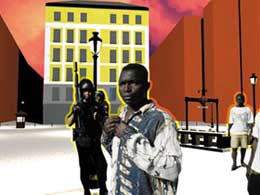Episode IV of the summary/translation of Laura Baigorri’ essay for GAME as CRITIC as ART. 2.0. (see Part I, II and III.) Reminder: the description of the games come from other sources.
We’ll end with two proposals ATYPICALS in an activist context: both are targeted to adolescents and children (10-15 year old) and both attempt to be competitive on the market, in terms of distribution.

– Super Kid Fighter (see previous post), by the Critical Art Ensemble and the Carbon Defense League, is based on the premise that due to the influence of games in childhood development, a GameBoy is the perfect media for tactical media activism targeting children.
The artists hacked the GameBoy. The resulting GameBoy ROM requires the player to wag school, sell drugs, work for the mafia and kill a policeman to obtain the reward of the game – free admission to the town’s newest brothel. The project was conceived prior to children gaining easy access to the internet. The project was coupled with a media package for teenage boys titled Child As Audience, which included radical software, instructions on how to hack a GameBoy, a CD of hardcore music, and a pamphlet on the oppression of youth.
A few years ago, the CAE even placed these “improved” games on store shelves in time for the Christmas shopping season.
One has to take into account the context in which the game was created. This strategy is targeted at the US where the educational system – institutional and media – tries to control as much as possible promiscuity and restricts the free sexual orientation of children, picturing homosexuality as some kind of crime. Let’s not forget either the emotional damage caused by the plethora of predicators, the inquisistion that Bill Clinton had to face because of his infidelity, and the ridiculous amount of media censorship triggered by Janet Jackson’s breast on TV. The game has therefore met with different expectations in “more sexually matured” societies.

– Bordergames* (see previous post) is about the many problems met by adolescent immigrants living in big city neighbourhoods.
The objective is to build a tool, in the form of a video game, which permits the youngsters to develop an expressive and organisational autonomy in order to portray themselves and the present state of their community, in an environment in which their cultural traditions mingle with the urban context in which they currently live. In turn, Bordergames will function as an instrument of political, social and cultural coordination and communication, in order to generate a sense of community and to share useful information with a wider audience through the game. La Fiambrera is working with young North Africans living in Lavapiés (Madrid) using OS tool (Blender, Crystal Space). The young people decide what will be the stories, critics and aspects of their life that will be experienced by the players of the game.
The objective of critical videogames for adolescents and children reminds the Jesuit aprocrypha “Leave them to me till they are 12, and they’ll be mine for life”. Although they have different objectives, these games have been used as an effective channel to explore social themes and reach younger audiences.
Conclusion:
Explicitely or implicitely, the aim of those games is to influence players, to make them question their own opinion/position in front of a specific theme, helping them to understand or to know that theme better. As game designer and academic game researcher Gonzalo Frasca said: “videogames are a great medium to convey political and social messages because they can relate between themselves hundreds of variables in the same time. It doesn’t mean that games can model perfectly a society, but at least, they can help players get a better understanding of complex situations”. The analysis of such games lead to a final reflection: the power of social or political videogames doesn’t depend so much on a concrete theme or message as on a desire of openness, understanding, socialization and education that looks for complices rather than addicts.
* Bordergames will be presented at Transmediale in Berlin next month.







